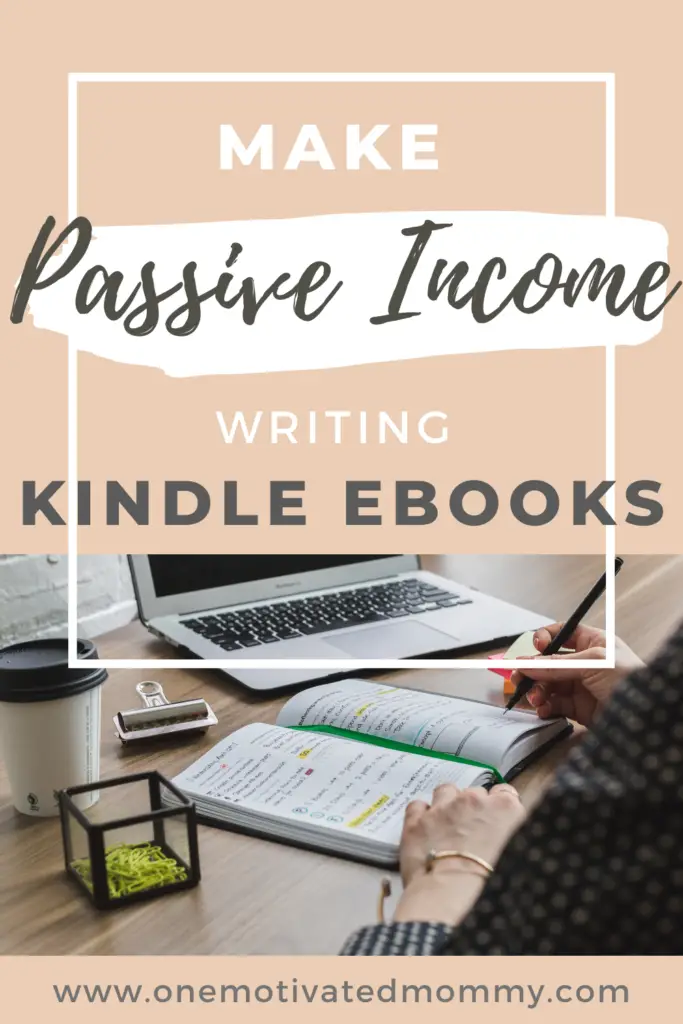Have you always wanted to write a book? Today it is easier than ever to become a published author and make passive income from the comfort of your home.

In the past, to get published you would have to find an agent or publisher, submit a query letter, a book proposal or your manuscript, and in the end, you could get rejected by the publisher.
Now, through the interconnectedness of the internet and the World Wide Web, authors have the opportunity to get their work out into the world at the click of a button, literally.
Authors and readers can also interact with each other directly through email and social media. Readers can give honest reviews and feedback to help authors improve and give insight into what they would like to read about.
I read a lot, and it is so refreshing after enjoying a piece by an author who was previously unknown to me to be able to look them up online and find a website or social media platform where I can leave feedback or see an interview or a TED talk by the author on YouTube. Years ago all you had was a tiny picture on the back cover of the book and maybe a little biography.
Kindle Direct Publishing (KDP) is a great platform to self-publish.
Once your manuscript is ready and your KDP account is set up, it takes just minutes to add a book to your bookshelf. You are walked through the entire process from start to finish and your book can be approved and on the Kindle Store in as little as 24 hours.
If you would like to write and publish your own books and make money from home as an authorpreneur, here is how to get started with Kindle Direct Publishing.

Set up Kindle Direct Publishing account
Setting up a KDP account is easy. Go to https://kdp.amazon.com and sign in with your Amazon account if you already have one or you can create a new account. Follow the steps to complete your KDP account.
You will be prompted to enter your name, address, payment method of receiving your royalties as well as tax information.
What are your long-term goals?
“A goal without a plan is just a wish.” ― Antoine de Saint-Exupéry
First of all, decide what your long-term goals for self-publishing are.
What is your why? Why do you want to write and publish your own book/s?
Is it that you want to be a romance novelist? Or write self-help/self-development books?
Is it that you have a story to tell that you know can help others who may be experiencing a similar situation?
Have you always wanted to immortalize recipes or life advice passed down to you from your grandmother?
Is it all of the above?
Is there a market for what you want to write?
Use the SMART method to outline your plans and set goals for your writing path and KDP journey.
SMART stands for Specific, Measurable, Attainable, Relevant and Time-bound.
- Specific – Select your niche.
- Measurable – How many words should your book be?
- Attainable – Able to be completed given your lifestyle, time and resources.
- Relevant – In line with the objectives of your project.
- Time-bound – Set a self-imposed deadline by which to finish write and another to publish/launch your book.
Do you need a pen name or pseudonym?
Decide on whether or not you will use a pseudonym or your real name on your book/s. You may want to use different pseudonyms for different books or genres of books. For example, if you write children’s books as well as romance novels, you can use a different pen name for each genre, up to 3 names per KDP account.
Find your Niche
Your niche is the area that you want to specialize in.
If you have expertise in a particular area like container gardening, landscaping, finance, pregnancy or postpartum fitness then you can write in that niche.
If, however, you do not have a set plan on what you want to write, then you need to find your niche.
A good way to discover niches is to browse the categories list on the Kindle bookstore on Amazon.
Also, go to Kindle eBooks and view the Popular in Kindle section. Scan the books in the Editor’s Picks and Best Sellers lists for ideas. There you can also see subcategories within niches if you want to ‘niche down’ and write on an even more specific topic.
Write out a list of potential niches you could write in. For example:
- Self-Care for Busy Moms
- Homesteading for Beginners
- Vegan Soapmaking
- 20-Minute Paleo Meals
- How to Create Passive Income from Home
Read reviews on books in your potential niche
This is a great way to get a feel for your target market. What have readers been seeking in a book and how has it helped them or changed their life? How have other books in your niche excelled or fallen short? Use this information to create a great product for your readers.
Come up with an awesome title and subtitle
The title of your book is what will draw readers to your work.
Brainstorm at least 5 different titles and subtitles using relevant keywords for your niche.
Your title may change after the book is written, but that is okay. When your ideas start to flow during the writing process you may come up with a book that is different/better than what you expected and your title may have to be changed as a result.
Create an outline
Now that you have decided on your niche, create an outline.
For a recipe book, for example, list the different sections or chapters like beverages, starters, main course, desserts etc. Then, write out the list of recipes that you want to include under each section.
When brainstorming, write out everything that comes to mind, even if you will not use it in your finished product. This is just to get all your ideas out on paper.
Have a writing schedule/plan
Based on your current lifestyle, when do you have time to write? Are you at your optimum brainpower first thing in the morning? Can you wake up an hour earlier to write?
How much time can you dedicate every day to writing?
Create a writing schedule that would allow you to complete your book by your deadline.
Start writing (and just write)
“There is nothing to writing. All you do is sit down at a typewriter and bleed.”
― Ernest Hemingway
Now that you have your outline and have set aside time to write… start to write!
Do not stop to correct grammar or do any editing. Let all your ideas, thoughts, feelings, whatever pertains to your piece, flow out of your head and through your fingers onto the page or screen.
Do not hold back!
Note, you do not have to start at the first section. Start wherever you feel most driven to write, whether this is in the middle or at the end. Just write!
Do this for every writing session until you have finished the first draft of your book.
Let it sit for a few days
Allow your book to sit and ‘marinade’ for a few days. This would allow you to not only get a rest but it would enable you to do your first edit with ‘fresh eyes’, a new perspective.
First Edit (spell check, grammar)
During the first edit, insert any images, add your Copyright and Disclaimer pages, Table of Contents, Preface, Acknowledgements, etc. where applicable.
Read your work and make corrections as you go along. Remove ideas that you think do not sit well in a chapter or paragraph and check for spelling and grammar errors.
A tool that I highly recommend is Grammarly.
Grammarly checks your text for spelling, punctuation, typographical and grammatical errors.
You can highlight a word and you will be offered synonyms instantly. This helps to increase your vocabulary and could help prevent word overuse. It also helps with sentence construction and it gives explanations for the suggested corrections.
There are free extensions for Chrome, Firefox, Microsoft Edge and Safari, a Desktop App for Mac or PC, as well as a free add-in for Microsoft Office.
You will definitely benefit from using Grammarly in your book-writing journey.
Second Edit
Again, leave your book for a day or two then return to it for another edit. Make any changes that you need to.
Let it sit for another day and design the cover in the meantime
If you are creative, you can design a beautiful book cover on Canva or PicMonkey
There is also the option to search for a freelance graphic designer on Fiverr who specializes in Kindle book covers (be sure to check their profile and read reviews).
There are a lot of good designers to choose from who can create a stunning, professional cover inexpensively. Reputable designers also are well-versed in the guidelines for KDP book covers.
Have someone else read your manuscript
It is a good idea to have a trusted person read your work to offer feedback.
Finalize – convert to HTML etc.
Go over your book one more time for your final edit. Once you are pleased with your finished product, you will need to convert it to HTML before submission to KDP. Don’t be intimidated by this as Amazon guides you through the steps.
Write compelling description
Write a description of your book. This is where readers can get an idea of the content of your book before buying. Make it as descriptive as possible, without any spoilers, enough to convince potential readers why they need to read your work.
Also, ensure that your description is polished and free of grammatical errors.
Publish!
Again, have no fear as you will be walked through the process from start to finish on KDP.
Upload your book and cover, include your marketing information and set your price (Amazon pays up to 70 percent in royalties).
You will have the opportunity to preview your book as it will be seen on Kindle apps and devices. If you notice any issues with your formatting etc., you can make adjustments to your original manuscript and resubmit it before publishing.
Once everything looks good click Publish!
Celebrate!
Congratulations! You have published your first book!
Now, go celebrate your newfound authorship and start thinking about your second book while you are at it!
Books I recommend to start you on your writing journey:
Butt-In-Chair: A No-Excuses Guide For Writers Who Struggle To Get Started by Jennifer Blanchard
The 15-Minute Writer: How To Write Your Book In Only 15 Minutes A Day by Jennifer Blanchard
How to Make a Living with Your Writing: Books, Blogging and More by Joanna Penn
On Writing: A Memoir of the Craft by Stephen King






